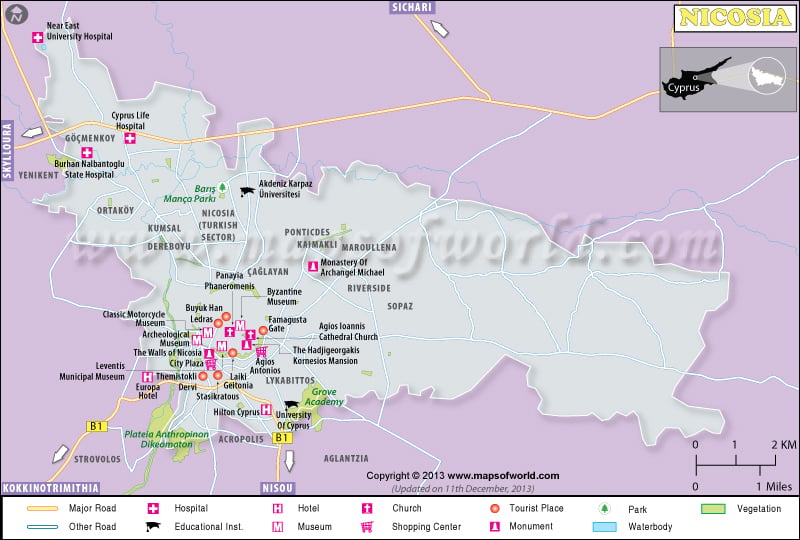About City :
Nicosia is the capital and the largest city of Cyprus, with an estimated population of 310,355. Nicosia (also known as Lefkoşa in Greek) has been inhabited since the early Bronze Age about 2500 years ago. It was originally built by the Achaeans at the end of the Trojan War. Later it was assimilated into the Byzantine Empire.
In the medieval ages, the city was sold several times, once to the Knights Templar, then to Guy of Lusignan (then ruler of Jerusalem). In the early fifteenth century, it fell into the hands of Mamelukes of Egypt, and only a century later was transferred into the Ottoman Empire. In 1878, the British colonized the city. An armed struggle against this colonization began in 1955. By 1960, Nicosia had become the capital of the Republic of Cyprus, at that time jointly governed by Greece and Turkey. In 1963, the city was divided into Greek and Turkish Cypriot quarters as a result of a conflict between the two administrative communities.
Due to its multicultural nature, both Greek and Turkish are spoken in the city. The predominant religion in the area is Greek Orthodox, followed by Islam. In 2011, Nicosia was declared the fifth richest city in the world, and was ranked as having one of the highest purchasing powers in the eastern Mediterranean region.
Geography :
Nicosia lies almost at the center of the island, on the banks of the River Pedieos. The city lies to the south of the Kyrenia Mountain range which lies in south central Cyprus. The average elevation is 220 meters. Ercan, Paphos and Larcana are cities near Nicosia.
How to Reach (Transport) :
Since the partition of the country, the Nicosia International Airport has been shut down. Travelers must arrive at Larnaca Airport (40km away) or Paphos Airport (120km away), from where shuttle buses can drop them to the city. Emirates, Transaero Airlines, Qatar Airways, British Airways, Air Astana, AtlasJet, Egypt Air, Aeroflot, MEA, Lufthansa, and Turkish Airlines have frequent flights to these airports. It is also possible to arrive in the country by sea, via cruise ships. It is possible for EU citizens to cross into Northern Cyprus, but may prove problematic for tourists who are not EU citizens.
Although Nicosia is a large city, it is possible to navigate large portions of it on foot. Maps are provided by the Nicosia City Tourism Organization. There is a bike sharing system and a vast bus network. Yellow taxis are a common sight, but the operators have a reputation for fleecing tourists. Hiring a vehicle is regarded as the best way to explore the city and its outliers.
When to Visit :
Nicosia can be visited at any time of the year, as it has a sub-tropical semi-arid climate. June to September are the summer months and consequently the prime tourist season, when the temperature is between 20° C – 40° C. The temperature falls below freezing point during winters from December to March. The rest of the year experiences autumnal weather in Cyprus.
Fairs and Festivals :
Festivals in Nicosia have a truly international vibe, with most of them related to human rights, music and movies.
-
Cyprus Film Days –
The CFD is a film festival when movies are screened at Cine-Studio and Pantheon Art Cinema in South Nicosia, usually mid-March.
-
Bellapais Music Festival –
From May to June, a music festival is celebrated in Bellapais, a village near Nicosia, where local talents perform in the abbey refectory.
-
Rainbow Day –
Rainbow day is celebrated mid-November to mark the importance of diversity and anti-racial sentiments.
- A festival named Kataklymos is celebrated mid-June to commemorate the mythical story of Noah and the Ark.
- August 30th is celebrated as Victory Day in North Nicosia.
- May 1st is an important day for South Nicosia and is celebrated as EU Accession Day.
- October 1st marks Cyprian Independence Day, and is celebrated with full gusto in Nicosia.
Points of Interest (Places to Visit) :
Both North Nicosia and South Nicosia are choc-a-block with places to visit. The Turkish bath called Omeriye Hammam, and the bedestan (old Turkish markets with unique architectural features) in North Nicosia are huge tourist attractions. Some of the interesting places are:
-
Cyprus Museum –
contains exhibits detailing the local history from 9th millennium BCE until the end of Antiquity. The Byzantine Museum has a unique collection of Orthodox icons and relics, dating from 9th -16th century A.D.
- The National Struggle Museum, the Museum of History of Cypriot Coinage and the Nicosia Municipal Arts Centre are award-winning museums in their own right.
-
Kumarcila Han –
A caravanserai (a place where travelers could rest after a long day) in North Nicosia has recently been renovated.
-
St. John’s Cathedral –
Built on the site of a Benedictine Chapel, the St. John’s Cathedral was originally a monastery. It is the official state church. The new Archbishop of Cyprus is coroneted in this cathedral. Only a short distance from the Cathedral is the Presidential Palace, home to the Head of the State.
-
Ostrich Wonderland Theme Park –
Europe’s largest ostrich farm is located only twenty five minutes away from Nicosia.
Accommodation :
Nicosia has a wide range of accommodation facilities available. Hilton Park Nicosia, Almond Business Suites and Cleopatra Hotel are among the most luxurious hotels in Nicosia. Other hotels and hostels like Europa Plaza Hotel, Semeli Hotel, and Holiday Inn Nicosia City Centre provide the basic facilities with the added advantage of being centrally located.
